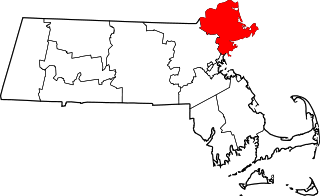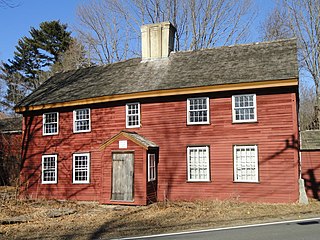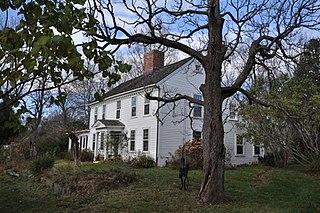
The North Shore is a region in the U.S. state of Massachusetts, loosely defined as the sea coast between Boston and New Hampshire. Its counterpart is the South Shore region extending south and east of Boston.

The Spencer–Peirce–Little Farm is a Colonial American farm located at 5 Little's Lane, Newbury, Massachusetts, United States, in the midst of 231 acres (93 ha) of open land bordering the Merrimack River and Plum Island Sound. The farmhouse, dating to c. 1690, was designated a National Historic Landmark in 1968 as an extremely rare 17th-century stone house in New England. It is now a nonprofit museum owned and operated by Historic New England and open to the public several days a week during the warmer months; an admission fee is charged for non Members.

This list is of that portion of the National Register of Historic Places (NRHP) designated in Essex County, Massachusetts. The locations of these properties and districts for which the latitude and longitude coordinates are included below, may be seen in a map.

The John Whipple House is a historic colonial house at 1 South Green in Ipswich, Massachusetts. Built in the seventeenth century, the house has been open to the public as a museum since 1899 and was the subject of some of the earliest attempts at the preservation of colonial houses. It was designated a National Historic Landmark in 1960, one of the earliest properties to receive that honor.

The Benjamin Abbot House or Abbot Homestead is a historic house at 9 Andover Street in Andover, Massachusetts, USA. The house was built in 1711. It was listed on the National Register of Historic Places in 1975.

The James Burnham House is a historic First Period house in Ipswich, Massachusetts. Burnham, who was apparently a wealthy man, lived in three different houses in the area from the 1670s to 1703. This is house is believed to be one that he purchased from Samuel Poad in 1677, based on what is known of the various properties and related transactions. The main body of the house exhibits no exposed evidence of its 17th century origins, but analysis of its structure reveals a set of features that make it nearly certain that it was built well before 1700. These diagnostic features include unusually large rooms, of a scale comparable to others in Ipswich, a spacing between joists that is distinctive to pre-1683 Ipswich houses, and a relatively steep roof pitch. Most of these features were covered over by alterations made to the interior during the Federal period, and the building's attic space has been finished over. A two-story ell was added onto the back of the house in the 19th century, and a porch was added in the 20th.

The East End Historic District encompasses the historic eastern portion of central Ipswich, Massachusetts. The now predominantly residential district is bounded on the north and west by East Street, running from its junction with North Main and High Streets to Jeffrey's Neck Road. The eastern boundary includes the Ipswich River and Turkey Shore Road from its junction with Labor-in-Vain Road to Green Street, and the southern boundary runs along Green Street to North Main. The district was listed on the National Register of Historic Places in 1980.

The George Giddings House and Barn is a historic First Period farm in Essex, Massachusetts. Both the house and the barn are estimated to have been built in the 1690s, and contain construction details unique in Essex County First Period buildings. The house was originally built as a single two story cell structure with a large chimney on one side, which was then widened with the addition of a second cell on the other side of the chimney. In the 19th century a number of alterations were made: the central chimney was removed, the entry of the house was reoriented from south to north by the addition of a new central door on the north face, and two new chimneys were added along the north elevation. The house has modern additions to the rear (south) side. The barn is of a similar vintage to the house, although it started with only five windows, and was extended at some point by the addition to the east of a sixth bay. It is one of a very few surviving First Period barns.

The Giddings-Burnham House is a historic house in Ipswich, Massachusetts. The house was probably built in the 1640s by George Giddings and was sold to his brother-in-law Thomas Burnham. The earliest documentation for this property was the deed of sale between George Giddings and Thomas Burnham in 1667 negating previous thoughts that the house was not built until 1680. The original house has been expanded and renovated and has a plaque on the door from the Ipswich Historical Commission stating that the home was built before 1667 by George Giddings.

The Hazen-Kimball-Aldrich House is a historic First Period house in Georgetown, Massachusetts.

The High Street Historic District is a predominantly residential historic district in Ipswich, Massachusetts. It encompasses the oldest section of High Street, which was laid out when Ipswich was founded in 1633. The district runs for four blocks from the junction with Town Farm Road and the railroad right-of-way in the west, to North Main Street in the east. The street was for several centuries part of the principal thoroughfare through the town, but became sidelined by the construction of Central Street in 1871, which bypassed traffic off most of this stretch of High Street.

Meetinghouse Green Historic District encompasses the historic 17th century heart of Ipswich, Massachusetts. The district runs along North Main Street, south from its junction with High Street to the southern end of the Meetinghouse Green. It was listed on the National Register of Historic Places in 1980.

The Stanley Lake House is a historic First Period house in Topsfield, Massachusetts. It is a 2+1⁄2-story wood-frame house that was built in stages by Mathew Stanley or his heirs between c. 1675 and 1693 and subsequently enlarged by the Lake family. It illustrates a host of building practices over the 17th and 18th centuries. The first Matthew Stanley house was said by Dow to be located northwest of this building. The first portion of this building is the section from the chimney westward. An easterly room was added after and a further addition to the east by the Lakes c. 1750. Matthew Stanley's heirs having removed to the Attleborough Falls area, sold the 70 acre farm property 1710- 1718 to Eleazer Lake. The property also includes a rare First Period barn. It was listed on the National Register of Historic Places in 1990. In 2005 it was named a contributing property to the River Road-Cross Street Historic District.

The Howe Village Historic District is a historic district in Boxford, Massachusetts. It encompasses an area in and around Massachusetts Route 97, just east of Interstate 95 and south of the junction of those two roads, and includes most of the properties on Ipswich Road and a few on adjacent roads. This area was among the first to be settled in what is now Boxford, and consists of a rural cluster of houses built between about 1750 and 1850. The district was listed on the National Register of Historic Places in 1973.

The House on Labor-in-Vain Road is a historic house in Ipswich, Massachusetts. Built about 1720 and enlarged c. 1810, it has a well-preserved assortment of architectural stylistic details predating 1850. It was listed on the National Register of Historic Places in 1990.

The Nathaniel Rust Mansion is a historic house at 83 County Street in Ipswich, Massachusetts. It is a 2+1⁄2-story colonial style house with First Period origins, indicated in part by its asymmetrical front facade. The date of its construction is uncertain; the first record of the house is its sale by Deacon William Goodhue to Nathaniel Rust, a tanner, in 1665. It was for many years located on the South Green, but was moved to its present location on County Street in 1837 by Asa Brown. Brown at the same time made modifications to the house, giving it its Federalist character. The house is one of the oldest houses in Ipswich that is situated outside one of its central historic districts.

The South Green Historic District encompasses one of the oldest central civic parts of Ipswich, Massachusetts. The town's South Green was laid out in 1686, and is now the heart of a collection of historic properties dating from the 17th to the 19th century. The centerpiece of the district is the green itself, and its most notable associated property is the John Whipple House, a National Historic Landmark and museum. The district boundaries extend from the junction of South Main and Elm Streets, southward past the green to where County Road crosses Saltonstall's Creek.

The Smith House, also known locally as the Tilton-Smith House, is a historic house in Ipswich, Massachusetts. Built in the first quarter of the 18th century, it is a good example of late First Period architecture. It suffered serious fire damage in 1998, but underwent a meticulous restoration. It was listed on the National Register of Historic Places in 1990.

This is a list of the National Register of Historic Places listings in Ipswich, Massachusetts.






















